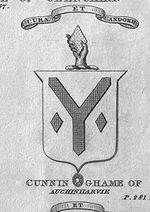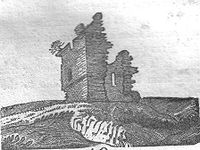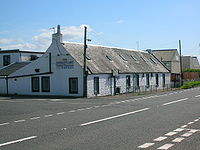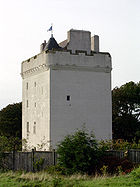
Auchenharvie Castle
Encyclopedia
Auchenharvie Castle is a ruined castle near Torranyard on the A 736 Glasgow to Irvine road. It lies in North Ayrshire
, Scotland
.

The ruins still stand in a prominent and strongly defensible position at Auchenharvie Farm near Torranyard; the site has been much altered by quarrying. Previously the castle was known as Achin-Hervy, Awthinharye in c 1564 (Rollie 1980), Auchinbervy by Moll in 1745, Achenhay (1775 & 1807), and Auchenhowy is used by Ainslie in 1821.
Auchenharvie has long been a ruin, shown as such as far back as 1604 - 08 by Timothy Pont
. It was too small and the area of the mound also so restricted that its conversion into a more commodious and comfortable dwelling were not practicable.
The corbels of the parapet are unusual in that they project less than usual and this links Auchenharvie with the work at Law Castle
and Barr Castle. The castle is built from whinstone
with freestone
corners.
A good deal remains of this typical tower castle, which has been ruinous since the 1770s, with indications of the barrel roof vaulting, side tower, ornate sandstone ornamentation, etc. Some very basic consolidation works have been carried out. It is a dangerous site to visit. Uncommon orchids have been recorded as growing on the motte.
It is known from the pollen record at Bloak Moss that extensive clearances took place here in the fifth or sixth centuries AD and such a site would have been of great strategic importance to these early settlers, standing out as it does, like an island above the mosses.
of Nova Scotia
in 1673 and was Physician to Charles II
in Scotland, appointed shortly after the King's coronation at Scone
in 1651. He was with the King's army at the defeat at Worcester in September 1651 and was made a prisoner in the Tower of London, being released after a ransom was paid. He was very wealthy and purchased back the Barony of Stevenston from the Earl of Eglinton in 1656. He died in 1676 and his son only outlived him by two years and because his daughter could not inherit, the land passed through the male line to her cousin, Robert Cunninghame.
In January 1678 Robert Cunynghame, apothecary / druggist in Edinburgh
, is stated to be the heir to Anne, daughter of Sir Robert Cunynghame of Auchenharvie. She was Robert's cousin-german and part of his inheritance was the Barony of Stevenston and the lands of Auchenharvie. He also owned some of the lands of Lambroughton
and Chapeltoun
. He married Anne Purves of Purves Hall in 1669 and had seventeen children. Despite his inheritance he later got into serious debt.
 The house belonged to David Cunningham, 1st Baronet of Auchinhervie, an absentee courtier in England, till 1642. He planned to add additional building in 1634, beginning with a garden wall around the old tower. He had thought the house too small to accommodate his friends in 1628 during a planned royal visit, so he asked his cousin David Cunningham of Robertland to accommodate his mother so that if his friends visited they could stay at Robertland instead.
The house belonged to David Cunningham, 1st Baronet of Auchinhervie, an absentee courtier in England, till 1642. He planned to add additional building in 1634, beginning with a garden wall around the old tower. He had thought the house too small to accommodate his friends in 1628 during a planned royal visit, so he asked his cousin David Cunningham of Robertland to accommodate his mother so that if his friends visited they could stay at Robertland instead.
In 1829 Aitken's map shows the castle as belonging to a Colonel Barns.
 A local legend is that in the days of the 'body snatchers' or 'resurrectionists'; before the Anatomy Act of 1832, bodies obtained locally were hidden in the ruins before being taken up to Glasgow at night to sell to the surgeons and medical students at the old university who practiced dissection skills on them. Another version of the story states that the bodies were collected together from neighbouring parishes at Darnshaw, a remote house near Bloak Moss on the old Auchenharvie to Megswell route. The bodies were then sold in Glasgow for £10 each to medicals students from the university. The old toll road did run past the site and a toll gate and house stood fairly close by which must cast some doubt on the castle being involved.
A local legend is that in the days of the 'body snatchers' or 'resurrectionists'; before the Anatomy Act of 1832, bodies obtained locally were hidden in the ruins before being taken up to Glasgow at night to sell to the surgeons and medical students at the old university who practiced dissection skills on them. Another version of the story states that the bodies were collected together from neighbouring parishes at Darnshaw, a remote house near Bloak Moss on the old Auchenharvie to Megswell route. The bodies were then sold in Glasgow for £10 each to medicals students from the university. The old toll road did run past the site and a toll gate and house stood fairly close by which must cast some doubt on the castle being involved.
A local legend involves nearby Girgenti House
and its prominent tower with smuggling.
was built by the family in Stevenston
and although demolished, the name lives on in Auchenharvie Academy
. Middleton near Annick Lodge had been part of the estate, passing into the hands of the Hamiltons of Bourtreehill
and then passing to the Earls of Eglinton
. Robert Cunninghame was one of the best known member of the family at its new site, being heavily involved in coal mining in the Barony of Stevenston.

Torranyard is a hamlet at a crossroads on the Irvine to Glasgow 'Lochlibo Road'. It was recorded as 'Turing Yard' in 1747, 'Turnyard' in 1775, 'Tirranyard' on Thomson's 1820 map and in 1832. On the 1860 OS map it is shown as having a toll booth and an inn called 'Tour', on the opposite side of the road from the present Torranyard Inn (2007). The Montgreenan estate and hotel
is nearby and the site of the old Girgenti
house and surviving tower are nearby on the Cunninghamhead
road.
A William Forgisal (Fergushill) of Torranyard was miner at the Doura Pit
in the 18th-century. He lost his leg in a mining accident, as had his father. William's wife was a tough sort, her comment being on seeing him so encumbered, was that the Forgisal's would need a small plantation of their own to keep them in crutches.
The castle mound today is rich in wildflowers, however any visitor should beware as the castle sits in an elevated position with an unfenced vertical drop.


North Ayrshire
North Ayrshire is one of 32 council areas in Scotland with a population of roughly 136,000 people. It is located in the south-west region of Scotland, and borders the areas of Inverclyde to the north, Renfrewshire to the north-east and East Ayrshire and South Ayrshire to the East and South...
, Scotland
Scotland
Scotland is a country that is part of the United Kingdom. Occupying the northern third of the island of Great Britain, it shares a border with England to the south and is bounded by the North Sea to the east, the Atlantic Ocean to the north and west, and the North Channel and Irish Sea to the...
.
The Castle

| Etymology |
| The meaning of Auchenharvie is suggested by Timothy Pont in 1604 - 08 as being 'the hill or 'knoppe' in the field of yellow corn'. |
The ruins still stand in a prominent and strongly defensible position at Auchenharvie Farm near Torranyard; the site has been much altered by quarrying. Previously the castle was known as Achin-Hervy, Awthinharye in c 1564 (Rollie 1980), Auchinbervy by Moll in 1745, Achenhay (1775 & 1807), and Auchenhowy is used by Ainslie in 1821.
Auchenharvie has long been a ruin, shown as such as far back as 1604 - 08 by Timothy Pont
Timothy Pont
Timothy Pont was a Scottish topographer, the first to produce a detailed map of Scotland. Pont's maps are among the earliest surviving to show a European country in minute detail, from an actual survey.-Life:...
. It was too small and the area of the mound also so restricted that its conversion into a more commodious and comfortable dwelling were not practicable.
The corbels of the parapet are unusual in that they project less than usual and this links Auchenharvie with the work at Law Castle
Law Castle
Law Castle is situated on the lower slopes of Law Hill in West Kilbride, only a short walk from the railway station. The castle is a simple rectangular structure with a sloped roof and several large chimneys protruding at each side....
and Barr Castle. The castle is built from whinstone
Whinstone
Whinstone is a term used in the quarrying industry to describe any hard dark-coloured rock. Examples include the igneous rocks basalt and dolerite as well as the sedimentary rock chert....
with freestone
Freestone
A freestone is a stone used in masonry for molding, tracery and other replication work required to be worked with the chisel. The freestone must be fine-grained, uniform and soft enough to be cut easily without shattering or splitting. Some sources say that the stone has no grain, but this is...
corners.
A good deal remains of this typical tower castle, which has been ruinous since the 1770s, with indications of the barrel roof vaulting, side tower, ornate sandstone ornamentation, etc. Some very basic consolidation works have been carried out. It is a dangerous site to visit. Uncommon orchids have been recorded as growing on the motte.
It is known from the pollen record at Bloak Moss that extensive clearances took place here in the fifth or sixth centuries AD and such a site would have been of great strategic importance to these early settlers, standing out as it does, like an island above the mosses.
The Cunninghames of Auchenharvie
The castle had long been in the hands of the Cunninghames and notably. Auchenharvie's most famous owner was Dr. Robert Cunninghame who was created a BaronetBaronet
A baronet or the rare female equivalent, a baronetess , is the holder of a hereditary baronetcy awarded by the British Crown...
of Nova Scotia
Nova Scotia
Nova Scotia is one of Canada's three Maritime provinces and is the most populous province in Atlantic Canada. The name of the province is Latin for "New Scotland," but "Nova Scotia" is the recognized, English-language name of the province. The provincial capital is Halifax. Nova Scotia is the...
in 1673 and was Physician to Charles II
Charles II of England
Charles II was monarch of the three kingdoms of England, Scotland, and Ireland.Charles II's father, King Charles I, was executed at Whitehall on 30 January 1649, at the climax of the English Civil War...
in Scotland, appointed shortly after the King's coronation at Scone
Scone, Scotland
Scone is a village in Perth and Kinross, Scotland. The medieval village of Scone, which grew up around the monastery and royal residence, was abandoned in the early 19th century when the residents were removed and a new palace was built on the site by the Earl of Mansfield...
in 1651. He was with the King's army at the defeat at Worcester in September 1651 and was made a prisoner in the Tower of London, being released after a ransom was paid. He was very wealthy and purchased back the Barony of Stevenston from the Earl of Eglinton in 1656. He died in 1676 and his son only outlived him by two years and because his daughter could not inherit, the land passed through the male line to her cousin, Robert Cunninghame.
In January 1678 Robert Cunynghame, apothecary / druggist in Edinburgh
Edinburgh
Edinburgh is the capital city of Scotland, the second largest city in Scotland, and the eighth most populous in the United Kingdom. The City of Edinburgh Council governs one of Scotland's 32 local government council areas. The council area includes urban Edinburgh and a rural area...
, is stated to be the heir to Anne, daughter of Sir Robert Cunynghame of Auchenharvie. She was Robert's cousin-german and part of his inheritance was the Barony of Stevenston and the lands of Auchenharvie. He also owned some of the lands of Lambroughton
Lambroughton
Lambroughton is a village in the old Barony of Kilmaurs, North Ayrshire, Scotland. This is a rural area famous for its milk and cheese production and the Ayrshire or Dunlop breed of cattle.-Origins of the name:...
and Chapeltoun
Chapeltoun
Chapeltoun is an estate on the banks of the Annick Water in East Ayrshire, Scotland. This is a rural area famous for its milk and cheese production and the Ayrshire or Dunlop breed of cattle.-Templeton and the Knights Templar:...
. He married Anne Purves of Purves Hall in 1669 and had seventeen children. Despite his inheritance he later got into serious debt.

In 1829 Aitken's map shows the castle as belonging to a Colonel Barns.
The Resurrectionists

A local legend involves nearby Girgenti House
Girgenti House
Girgenti House was a small, rather eccentric mansion built on part of the old Barony of Bonshaw in the parish of Stewarton, East Ayrshire, Scotland.-Bonnyton:...
and its prominent tower with smuggling.
Auchenharvie House
An estate named AuchenharvieAuchenharvie
Auchenharvie is an area of Stevenston, North Ayrshire in Scotland.There are therefore several local institutions, organizations and businesses that use this name. Such as:*Auchenharvie Colliery*Auchenharvie Academy* Auchenharvie House and estate....
was built by the family in Stevenston
Stevenston
Stevenston is a town in North Ayrshire, Scotland. It is one of the 'Three Towns' along with Ardrossan and Saltcoats.-History:The town is named after Stephan Loccard or Lockhart, whose father obtained a grant of land from Richard de Morville, Lord Cunninghame and Constable of Scotland, around 1170....
and although demolished, the name lives on in Auchenharvie Academy
Auchenharvie Academy
Auchenharvie Academy in North Ayrshire is a secondary school based in Stevenston, Ayrshire, Scotland. It is a comprehensive school which takes children from the ages of 11–18 from Stevenston and Saltcoats of North Ayrshire area.- History :...
. Middleton near Annick Lodge had been part of the estate, passing into the hands of the Hamiltons of Bourtreehill
Bourtreehill House
Bourtreehill House and the enclosed land on which it was built form the original estate of Bourtreehill. The wooded hill-top, a distinctive feature of the estate, is now a landmark that sits at the centre of modern North Bourtreehill in the district of North Ayrshire on the west coast of...
and then passing to the Earls of Eglinton
Earl of Eglinton
Earl of Eglinton is a title in the Peerage of Scotland.Some authorities spell the title: Earl of Eglintoun In 1859 the thirteenth Earl of Eglinton, Archibald Montgomerie, was also created Earl of Winton in the Peerage of the United Kingdom, which gave him an automatic seat in the House of Lords,...
. Robert Cunninghame was one of the best known member of the family at its new site, being heavily involved in coal mining in the Barony of Stevenston.
The Toll Road
The old toll house close to Auchenharvie Castle farm was demolished in the 1990s and a private house with that name now stands on the site. The toll road junction is still extant as farm tracks. A road used to run across the fields from here to cut across the river by a ford below Megswell farm. This road passed beneath the Montgreenan driveway which was carried by a highly ornate bridge at this point. The construction of the Lochlibo Road made this route redundant.Etymology and natural history

| Etymology of Torranyard |
| The meaning of 'Tour' in Scots is 'Tower', as in the prominent Auchenharvie castle tower nearby. A Yard in Scots is a garden. 'Torranyard' could therefore be a corruption of 'Tour Inn yard.' Local people still pronounce the name 'Torranyard' as 'TOURanyard'. 'Torran' is also a Gaelic word meaning a small hill. |
Torranyard is a hamlet at a crossroads on the Irvine to Glasgow 'Lochlibo Road'. It was recorded as 'Turing Yard' in 1747, 'Turnyard' in 1775, 'Tirranyard' on Thomson's 1820 map and in 1832. On the 1860 OS map it is shown as having a toll booth and an inn called 'Tour', on the opposite side of the road from the present Torranyard Inn (2007). The Montgreenan estate and hotel
Auchentiber
The hamlet of Auchentiber is in North Ayrshire, Parish of Kilwinning, Scotland. Auchentiber is NE of Kilwinning on the Lochlibo Road, from the hamlet of Burnhouse and from the village of Barrmill. Grid Ref. NS3647. Some new housing has been built, but the settlement is still very much a hamlet...
is nearby and the site of the old Girgenti
Chapeltoun
Chapeltoun is an estate on the banks of the Annick Water in East Ayrshire, Scotland. This is a rural area famous for its milk and cheese production and the Ayrshire or Dunlop breed of cattle.-Templeton and the Knights Templar:...
house and surviving tower are nearby on the Cunninghamhead
Cunninghamhead
Cunninghamhead is a hamlet in North Ayrshire, Scotland. It was the centre of the lands of Cunninghamhead, Perceton and Annick Lodge in Cunninghame...
road.
A William Forgisal (Fergushill) of Torranyard was miner at the Doura Pit
Benslie
Benslie is a small village in North Ayrshire, in the parish of Kilwinning, Scotland. Map reference NS 336 429.- History :This village, previously Benislay , Beinslay , Bainsley in 1821 , Bensley , Benslee or Benslee square on the 1860 OS map, Bendslee is situated next to Benslie wood...
in the 18th-century. He lost his leg in a mining accident, as had his father. William's wife was a tough sort, her comment being on seeing him so encumbered, was that the Forgisal's would need a small plantation of their own to keep them in crutches.
The castle mound today is rich in wildflowers, however any visitor should beware as the castle sits in an elevated position with an unfenced vertical drop.
See also


- AuchentiberAuchentiberThe hamlet of Auchentiber is in North Ayrshire, Parish of Kilwinning, Scotland. Auchentiber is NE of Kilwinning on the Lochlibo Road, from the hamlet of Burnhouse and from the village of Barrmill. Grid Ref. NS3647. Some new housing has been built, but the settlement is still very much a hamlet...
- CunninghamheadCunninghamheadCunninghamhead is a hamlet in North Ayrshire, Scotland. It was the centre of the lands of Cunninghamhead, Perceton and Annick Lodge in Cunninghame...
- ChapeltounChapeltounChapeltoun is an estate on the banks of the Annick Water in East Ayrshire, Scotland. This is a rural area famous for its milk and cheese production and the Ayrshire or Dunlop breed of cattle.-Templeton and the Knights Templar:...
- Corsehill
- ChapeltounChapeltounChapeltoun is an estate on the banks of the Annick Water in East Ayrshire, Scotland. This is a rural area famous for its milk and cheese production and the Ayrshire or Dunlop breed of cattle.-Templeton and the Knights Templar:...
- Girgenti HouseGirgenti HouseGirgenti House was a small, rather eccentric mansion built on part of the old Barony of Bonshaw in the parish of Stewarton, East Ayrshire, Scotland.-Bonnyton:...
- PercetonPercetonPerceton is a medieval settlement and estate in North Ayrshire, Scotland, near the town of Irvine. The old church in Perceton is one of the oldest buildings in the Irvine district...
- Annick Lodge
- Barony and Castle of GiffenBarony and Castle of GiffenThe Barony of Giffen and its associated 15th-century castle were in the parish of Beith in the former District of Cunninghame, now North Ayrshire. The site may be spelled Giffen or Giffin and lay within the Lordship of Giffin, which included the Baronies of Giffen, Trearne, Hessilhead, Broadstone,...

